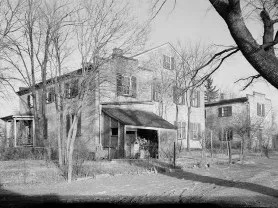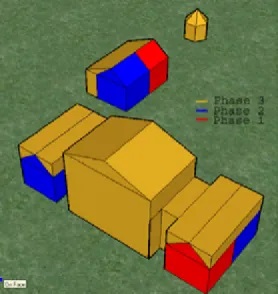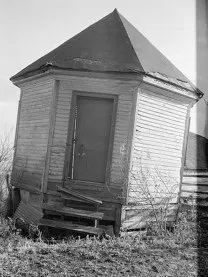Happy Retreat: a Washington Family Home

“Historic home” is a catch-all term that often fails to adequately describe the complex life and development of a dwelling. As properties change hands, new owners modify the structures and sites to better suit their own needs or the dictates of fashion. Happy Retreat, one of the stops on the Trust’s Fall Symposium to Virginia’s Northern Valleys, not only possesses a rich pre-Revolutionary connection to the Washington family, but a vibrant history, with a new and exciting chapter in its life, as a public venue, that is just beginning.
The land upon which Jefferson County and Charles Town, West Virginia (not to be confused with Charleston, the state’s capitol) sit was owned by Charles Washington—George Washington’s youngest brother—who inherited property from their half-brother Lawrence. Charles began laying out the present estate in 1780, and Charles Town in 1786, naming the streets for his older brothers, as well as his wife Mildred. Evidently the town was a bigger concern to Charles than his house. Architectural analysis by Matt Webster, Director of Architectural Resources at Colonial Williamsburg and a native of Jefferson County, confirms the long-held local knowledge that Charles and his family lived in two small brick structures (today comprising the east and west wings of the house), connected by a breezeway. Most of the house we see today was completely unknown to its most famous residents. The center block of the house was not built until 1837 under the ownership of Isaac A. Douglas, who renamed it Mordington after his family’s ancestral home in Scotland. Thankfully, Charles’ original structures and outbuildings were incorporated into the new design, preserving the spaces where his family lived and entertained his famous brother.
Happy Retreat, front elevation, c. 1937. Image courtesy of the Historic American Buildings Survey, Library of Congress.
Happy Retreat, rear elevation, c. 1937. The portico at the extreme left of the image, marks part of Charles Washington’s original structure. Image courtesy of the Historic American Buildings Survey, Library of Congress.
Sadly, little seems to be recorded of Charles or his life in the house although George Washington was fond of visiting him as well as their brother Samuel, who also lived in Charles Town in a house called Harewood, which remains in the Washington family. George’s diary entries reveal that he spent the night at Happy Retreat, making it one of the comparably few houses in the country that can undeniably prove that “George Washington slept here.”
Although Happy Retreat has remained structurally intact since 1837, the house’s contents have not. When the property left the care of Washington’s descendents, original furniture and possessions went with them, and have largely been lost to history. A family of local furniture makers, the Conklyns, lived there for a time and used it as their workshop, fortunately preserving all the original woodwork. The 1940s proved to be a particularly colorful time in the house’s history, as it was briefly owned by R. J. Funkhouser, a West Virginia-born industrialist “who had a taste for Washington family estates.” Happy Retreat was one of several local properties, including Cedar Lawn, Blakely, and Claymont Court, to be purchased, restored according to historic records, and decorated with fine antiques. For two decades, these contiguous Washington estates became a Funkhouser family compound known collectively as O’Sullivan Farms, after R. J.’s shoe heel manufacturing corporation in Winchester, Virginia. Beginning in the late 1960s, the Funkhousers began divesting themselves of the historic estates one by one. William Gavin purchased Happy Retreat in 1968, and he and his wife lived there until the turn of the 21st century.
Happy Retreat, kitchen photographed c. 1937. The right side of the building dates from Charles Washington’s earliest occupation. Image courtesy of the Historic American Buildings Survey, Library of Congress.
Happy Retreat, schoolhouse built in 1837, photographed c. 1937. Image courtesy of the Historic American Buildings Survey, Library of Congress.
In 2003, the Gavins put the house on the market. A property appraisal by the City of Charles Town showed that the land could potentially be subdivided for residential use, which worried local preservationists. Headed by Walter Washington, a direct descendent of George and Charles’ brother Samuel, a non-profit group named Friends of Happy Retreat formed to advocate for the acquisition, preservation, and reuse of the property. All told, the process took nearly nine years. Friends of Happy Retreat acquired the house and two acres outright in 2014, and the City of Charles Town purchased the remaining ten acres for use as a community park.
Friends of Happy Retreat find themselves in a unique position. Although seven Washington family homes are extant in Jefferson County, Charles Washington’s house is the first open to the general public. While making Happy Retreat a traditional house museum certainly holds an attraction, the challenge of furnishing an entirely empty structure with authentic objects—even if they had no direct connection to the Washingtons—would be difficult, costly, and limit the site’s potential. Even acquiring just one Washington family object would pose a challenge–any time one comes on the market the competition between collectors and museums is keen. Instead, the Friends and the town will collaborate to make Happy Retreat a destination: a location for community events, art exhibits, and festivals. The Trust’s visit to Happy Retreat in October will be an exciting opportunity to explore a significant property that has long been out of public view, and we look forward following the site’s progress as it develops its identity and unique niche.
About The Decorative Arts Trust Bulletin
Formerly known as the "blog,” the Bulletin features new research and scholarship, travelogues, book reviews, and museum and gallery exhibitions. The Bulletin complements The Magazine of the Decorative Arts Trust, our biannual members publication.













